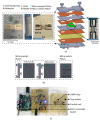Heater Integrated Lab-on-a-Chip Device for Rapid HLA Alleles Amplification towards Prevention of Drug Hypersensitivity
- PMID: 34068416
- PMCID: PMC8153606
- DOI: 10.3390/s21103413
Heater Integrated Lab-on-a-Chip Device for Rapid HLA Alleles Amplification towards Prevention of Drug Hypersensitivity
Abstract
HLA-B*15:02 screening before administering carbamazepine is recommended to prevent life-threatening hypersensitivity. However, the unavailability of a point-of-care device impedes this screening process. Our research group previously developed a two-step HLA-B*15:02 detection technique utilizing loop-mediated isothermal amplification (LAMP) on the tube, which requires two-stage device development to translate into a portable platform. Here, we report a heater-integrated lab-on-a-chip device for the LAMP amplification, which can rapidly detect HLA-B alleles colorimetrically. A gold-patterned micro-sized heater was integrated into a 3D-printed chip, allowing microfluidic pumping, valving, and incubation. The performance of the chip was tested with color dye. Then LAMP assay was conducted with human genomic DNA samples of known HLA-B genotypes in the LAMP-chip parallel with the tube assay. The LAMP-on-chip results showed a complete match with the LAMP-on-tube assay, demonstrating the detection system's concurrence.
Keywords: lab-on-a-chip; loop-mediated isothermal amplification; microfluidics; pharmaco-genetics; point-of-care diagnostics.
Conflict of interest statement
The authors declare no conflict of interest.
Figures







Similar articles
-
An interdigitated electrode biosensor platform for rapid HLA-B*15:02 genotyping for prevention of drug hypersensitivity.Biosens Bioelectron. 2018 Jul 15;111:174-183. doi: 10.1016/j.bios.2018.01.063. Epub 2018 Feb 2. Biosens Bioelectron. 2018. PMID: 29673585
-
Development of a self-contained microfluidic chip and an internet-of-things-based point-of-care device for automated identification of respiratory viruses.Lab Chip. 2024 Apr 30;24(9):2485-2496. doi: 10.1039/d3lc00933e. Lab Chip. 2024. PMID: 38587207
-
A Finger-Actuated Sample-Dosing Capillary-Driven Microfluidic Device for Loop-Mediated Isothermal Amplification.Biosensors (Basel). 2024 Aug 23;14(9):410. doi: 10.3390/bios14090410. Biosensors (Basel). 2024. PMID: 39329785 Free PMC article.
-
Paper-based microfluidics for rapid diagnostics and drug delivery.J Control Release. 2020 Jun 10;322:187-199. doi: 10.1016/j.jconrel.2020.03.010. Epub 2020 Mar 10. J Control Release. 2020. PMID: 32169536 Review.
-
LAMP-Based Point-of-Care Biosensors for Rapid Pathogen Detection.Biosensors (Basel). 2022 Nov 23;12(12):1068. doi: 10.3390/bios12121068. Biosensors (Basel). 2022. PMID: 36551035 Free PMC article. Review.
Cited by
-
Recent advances and challenges in temperature monitoring and control in microfluidic devices.Electrophoresis. 2023 Jan;44(1-2):268-297. doi: 10.1002/elps.202200162. Epub 2022 Oct 25. Electrophoresis. 2023. PMID: 36205631 Free PMC article. Review.
-
Electric Cell-substrate Impedance Sensing in Biocompatibility Research.J Electr Bioimpedance. 2021 Dec 30;12(1):163-168. doi: 10.2478/joeb-2021-0019. eCollection 2021 Jan. J Electr Bioimpedance. 2021. PMID: 35111271 Free PMC article.
-
Rapid on-site nucleic acid testing: On-chip sample preparation, amplification, and detection, and their integration into all-in-one systems.Front Bioeng Biotechnol. 2023 Feb 1;11:1020430. doi: 10.3389/fbioe.2023.1020430. eCollection 2023. Front Bioeng Biotechnol. 2023. PMID: 36815884 Free PMC article. Review.
-
High-Performance, Easy-to-Fabricate, Nanocomposite Heater for Life Sciences and Biomedical Applications.Polymers (Basel). 2024 Apr 20;16(8):1164. doi: 10.3390/polym16081164. Polymers (Basel). 2024. PMID: 38675084 Free PMC article.
References
-
- Roujeau J.-C., Kelly J.P., Naldi L., Rzany B., Stern R.S., Anderson T., Auquier A., Bastuji-Garin S., Correia O., Locati F., et al. Medication Use and the Risk of Stevens–Johnson Syndrome or Toxic Epidermal Necrolysis. N. Engl. J. Med. 1995;333:1600–1608. doi: 10.1056/NEJM199512143332404. - DOI - PubMed
MeSH terms
Substances
Supplementary concepts
LinkOut - more resources
Full Text Sources
Medical
Research Materials
Miscellaneous

